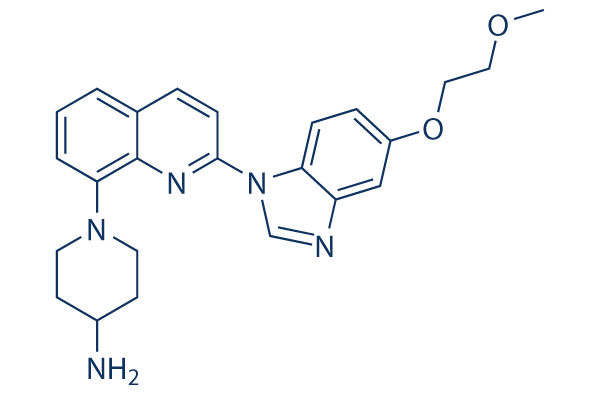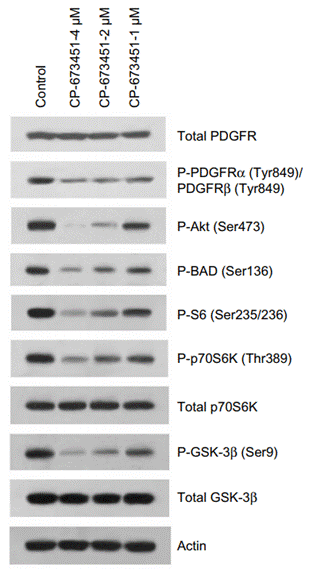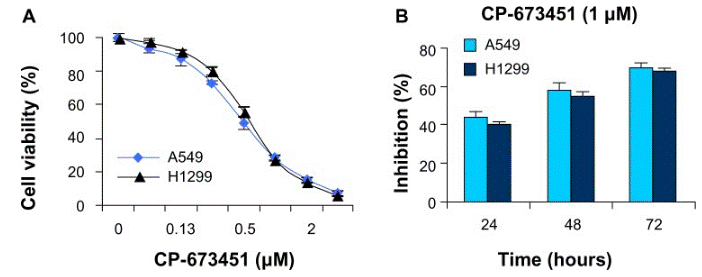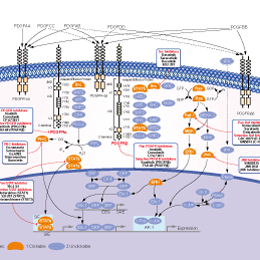
- Bioactive Compounds
- By Signaling Pathways
- PI3K/Akt/mTOR
- Epigenetics
- Methylation
- Immunology & Inflammation
- Protein Tyrosine Kinase
- Angiogenesis
- Apoptosis
- Autophagy
- ER stress & UPR
- JAK/STAT
- MAPK
- Cytoskeletal Signaling
- Cell Cycle
- TGF-beta/Smad
- DNA Damage/DNA Repair
- Compound Libraries
- Popular Compound Libraries
- Customize Library
- Clinical and FDA-approved Related
- Bioactive Compound Libraries
- Inhibitor Related
- Natural Product Related
- Metabolism Related
- Cell Death Related
- By Signaling Pathway
- By Disease
- Anti-infection and Antiviral Related
- Neuronal and Immunology Related
- Fragment and Covalent Related
- FDA-approved Drug Library
- FDA-approved & Passed Phase I Drug Library
- Preclinical/Clinical Compound Library
- Bioactive Compound Library-I
- Bioactive Compound Library-Ⅱ
- Kinase Inhibitor Library
- Express-Pick Library
- Natural Product Library
- Human Endogenous Metabolite Compound Library
- Alkaloid Compound LibraryNew
- Angiogenesis Related compound Library
- Anti-Aging Compound Library
- Anti-alzheimer Disease Compound Library
- Antibiotics compound Library
- Anti-cancer Compound Library
- Anti-cancer Compound Library-Ⅱ
- Anti-cancer Metabolism Compound Library
- Anti-Cardiovascular Disease Compound Library
- Anti-diabetic Compound Library
- Anti-infection Compound Library
- Antioxidant Compound Library
- Anti-parasitic Compound Library
- Antiviral Compound Library
- Apoptosis Compound Library
- Autophagy Compound Library
- Calcium Channel Blocker LibraryNew
- Cambridge Cancer Compound Library
- Carbohydrate Metabolism Compound LibraryNew
- Cell Cycle compound library
- CNS-Penetrant Compound Library
- Covalent Inhibitor Library
- Cytokine Inhibitor LibraryNew
- Cytoskeletal Signaling Pathway Compound Library
- DNA Damage/DNA Repair compound Library
- Drug-like Compound Library
- Endoplasmic Reticulum Stress Compound Library
- Epigenetics Compound Library
- Exosome Secretion Related Compound LibraryNew
- FDA-approved Anticancer Drug LibraryNew
- Ferroptosis Compound Library
- Flavonoid Compound Library
- Fragment Library
- Glutamine Metabolism Compound Library
- Glycolysis Compound Library
- GPCR Compound Library
- Gut Microbial Metabolite Library
- HIF-1 Signaling Pathway Compound Library
- Highly Selective Inhibitor Library
- Histone modification compound library
- HTS Library for Drug Discovery
- Human Hormone Related Compound LibraryNew
- Human Transcription Factor Compound LibraryNew
- Immunology/Inflammation Compound Library
- Inhibitor Library
- Ion Channel Ligand Library
- JAK/STAT compound library
- Lipid Metabolism Compound LibraryNew
- Macrocyclic Compound Library
- MAPK Inhibitor Library
- Medicine Food Homology Compound Library
- Metabolism Compound Library
- Methylation Compound Library
- Mouse Metabolite Compound LibraryNew
- Natural Organic Compound Library
- Neuronal Signaling Compound Library
- NF-κB Signaling Compound Library
- Nucleoside Analogue Library
- Obesity Compound Library
- Oxidative Stress Compound LibraryNew
- Plant Extract Library
- Phenotypic Screening Library
- PI3K/Akt Inhibitor Library
- Protease Inhibitor Library
- Protein-protein Interaction Inhibitor Library
- Pyroptosis Compound Library
- Small Molecule Immuno-Oncology Compound Library
- Mitochondria-Targeted Compound LibraryNew
- Stem Cell Differentiation Compound LibraryNew
- Stem Cell Signaling Compound Library
- Natural Phenol Compound LibraryNew
- Natural Terpenoid Compound LibraryNew
- TGF-beta/Smad compound library
- Traditional Chinese Medicine Library
- Tyrosine Kinase Inhibitor Library
- Ubiquitination Compound Library
-
Cherry Picking
You can personalize your library with chemicals from within Selleck's inventory. Build the right library for your research endeavors by choosing from compounds in all of our available libraries.
Please contact us at [email protected] to customize your library.
You could select:
- Antibodies
- Bioreagents
- qPCR
- 2x SYBR Green qPCR Master Mix
- 2x SYBR Green qPCR Master Mix(Low ROX)
- 2x SYBR Green qPCR Master Mix(High ROX)
- Protein Assay
- Protein A/G Magnetic Beads for IP
- Anti-Flag magnetic beads
- Anti-Flag Affinity Gel
- Anti-Myc magnetic beads
- Anti-HA magnetic beads
- Magnetic Separator
- Poly DYKDDDDK Tag Peptide lyophilized powder
- Protease Inhibitor Cocktail
- Protease Inhibitor Cocktail (EDTA-Free, 100X in DMSO)
- Phosphatase Inhibitor Cocktail (2 Tubes, 100X)
- Cell Biology
- Cell Counting Kit-8 (CCK-8)
- Animal Experiment
- Mouse Direct PCR Kit (For Genotyping)
- New Products
- Contact Us
CP-673451
CP-673451 is a selective inhibitor of PDGFRα/β with IC50 of 10 nM/1 nM in cell-free assays, exhibits >450-fold selectivity over other angiogenic receptors, has antiangiogenic and antitumor activity.

CP-673451 Chemical Structure
CAS No. 343787-29-1
Purity & Quality Control
Batch:
Purity:
99.89%
99.89
CP-673451 Related Products
| Related Targets | PDGFRα PDGFRβ | Click to Expand |
|---|---|---|
| Related Products | Crenolanib Orantinib (SU6668) Tyrphostin AG 1296 Trapidil PP121 AZD2932 | Click to Expand |
| Related Compound Libraries | Kinase Inhibitor Library Tyrosine Kinase Inhibitor Library PI3K/Akt Inhibitor Library Cell Cycle compound library Angiogenesis Related compound Library | Click to Expand |
Signaling Pathway
Cell Data
| Cell Lines | Assay Type | Concentration | Incubation Time | Formulation | Activity Description | PMID |
|---|---|---|---|---|---|---|
| DAOY | qHTS assay | qHTS of pediatric cancer cell lines to identify multiple opportunities for drug repurposing: Primary screen for DAOY cells | 29435139 | |||
| SJ-GBM2 | qHTS assay | qHTS of pediatric cancer cell lines to identify multiple opportunities for drug repurposing: Primary screen for SJ-GBM2 cells | 29435139 | |||
| A673 | qHTS assay | qHTS of pediatric cancer cell lines to identify multiple opportunities for drug repurposing: Primary screen for A673 cells | 29435139 | |||
| BT-37 | qHTS assay | qHTS of pediatric cancer cell lines to identify multiple opportunities for drug repurposing: Primary screen for BT-37 cells | 29435139 | |||
| NB-EBc1 | qHTS assay | qHTS of pediatric cancer cell lines to identify multiple opportunities for drug repurposing: Primary screen for NB-EBc1 cells | 29435139 | |||
| U-2 OS | qHTS assay | qHTS of pediatric cancer cell lines to identify multiple opportunities for drug repurposing: Primary screen for U-2 OS cells | 29435139 | |||
| Saos-2 | qHTS assay | qHTS of pediatric cancer cell lines to identify multiple opportunities for drug repurposing: Primary screen for Saos-2 cells | 29435139 | |||
| SK-N-SH | qHTS assay | qHTS of pediatric cancer cell lines to identify multiple opportunities for drug repurposing: Primary screen for SK-N-SH cells | 29435139 | |||
| NB1643 | qHTS assay | qHTS of pediatric cancer cell lines to identify multiple opportunities for drug repurposing: Primary screen for NB1643 cells | 29435139 | |||
| LAN-5 | qHTS assay | qHTS of pediatric cancer cell lines to identify multiple opportunities for drug repurposing: Primary screen for LAN-5 cells | 29435139 | |||
| BT-12 | qHTS assay | qHTS of pediatric cancer cell lines to identify multiple opportunities for drug repurposing: Primary screen for BT-12 cells | 29435139 | |||
| Rh18 | qHTS assay | qHTS of pediatric cancer cell lines to identify multiple opportunities for drug repurposing: Primary screen for Rh18 cells | 29435139 | |||
| OHS-50 | qHTS assay | qHTS of pediatric cancer cell lines to identify multiple opportunities for drug repurposing: Primary screen for OHS-50 cells | 29435139 | |||
| RD | qHTS assay | qHTS of pediatric cancer cell lines to identify multiple opportunities for drug repurposing: Primary screen for RD cells | 29435139 | |||
| MG 63 (6-TG R) | qHTS assay | qHTS of pediatric cancer cell lines to identify multiple opportunities for drug repurposing: Primary screen for MG 63 (6-TG R) cells | 29435139 | |||
| Rh41 | qHTS assay | qHTS of pediatric cancer cell lines to identify multiple opportunities for drug repurposing: Primary screen for Rh41 cells | 29435139 | |||
| Click to View More Cell Line Experimental Data | ||||||
Biological Activity
| Description | CP-673451 is a selective inhibitor of PDGFRα/β with IC50 of 10 nM/1 nM in cell-free assays, exhibits >450-fold selectivity over other angiogenic receptors, has antiangiogenic and antitumor activity. | ||||
|---|---|---|---|---|---|
| Targets |
|
| In vitro | ||||
| In vitro | CP 673451 is a selective inhibitor of PDGFRα/β with IC50 of 10 nM/1 nM, exhibits >450-fold selectivity over other angiogenic receptors. In glioblastoma tumors, CP-673451 (33 mg/kg) provides >50% inhibition of PDGFR-β receptor for 4 hours corresponding to an EC50 of 120 ng/mL in plasma at Cmax. In a sponge angiogenesis model, CP-673451 inhibits 70% of PDGF-BB-stimulated angiogenesis at a dose of 3 mg/kg (q.d. ×5, p.o., corresponding to 5.5 ng/mL at Cmax).[1] CP-673451 decreases cell proliferation rate through mechanisms involving reduced phosphorylation of GSK-3α and GSK-3β. In both RD and RUCH2 cultures, CP-673451 impairs rhabdosphere-forming capacity and cell differentiation, causes increased senescence. [2] |
|||
|---|---|---|---|---|
| Kinase Assay | Kinase inhibition assay | |||
| A glutathione S-transferase-tagged kinase domain construct of the intracellular portion of the PDGFR-β (amino acids 693-1401, accession no. J03278) is expressed in Sf-9 cells (baculovirus expression system). Enzyme kinetics are determined by incubating the enzyme with increasing concentrations of ATP in phosphorylation buffer [50 mmol/L HEPES (pH 7.3), 125 mmol/L NaCl, 24 mmol/L MgCl2 in Nunc Immuno MaxiSorp 96-well plates previously coated with 100 μL of 100 μg/mL poly-Glu-Tyr (4:1 ratio) diluted in PBS. After 10 minutes, the plates are washed (PBS, 0.1% Tween 20), incubated with anti-phosphotyrosine-horseradish peroxidase antibody, and diluted in PBS, 0.05% Tween 20, 3% BSA for 30 minutes at room temperature. The plates are washed as above and incubated with 3,3 | ||||
| Cell Research | Cell lines | PAE | ||
| Concentrations | ~3000 nM | |||
| Incubation Time | 18 min | |||
| Method | PAE cells stably expressing full-length PDGFR and VEGFR have been generated. For cell-based selectivity assays, PAE cells are transfected with fulllength human PDGFR-a, PDGFR-h, or VEGFR-2. Cells are seeded at 4×105 cells/mL in 50 μL growth medium (Ham's F-12 media supplemented with 10% fetal bovine serum, 50,000 units each penicillin and streptomycin. After 6 to 8 hours, the growth medium is replaced with 50 μL serum-depleted medium (as above, but with 0.1% fetal bovine serum) and cells are incubated overnight. Immediately before compound addition, the medium was replaced with 95 μL serum-depleted medium. Compounds are diluted in 100% DMSO, added to the cells at a final DMSO concentration of 0.25% v/v, and incubated at 37°C for 10 minutes. Cells are stimulated with the appropriate ligand and incubated as above for an additional 8 minutes. The medium is removed and the cells washed once with PBS, then lysed with 50 μL HNTG buffer [20 mmol/L HEPES (pH 7.5), 150 mmol/L NaCl, 2% Triton X-100, 10% glycerol, 5 μmol/L EDTA, 2 mmol/L NaVO4, and 1 EDTA-free complete protease inhibitor tablet per 25 mL] for 5 minutes at room temperature. Lysates are then diluted with 50 μL HG buffer [20 mmol/L HEPES (pH 7.5), 10% glycerol]. The diluted cell lysates are mixed thoroughly, 50 μL of supernatant are transferred to the ELISA capture plate, and incubated at room temperature for 2 hours with agitation. ELISA capture plates are prepared by coating 96-well ReactiBind goat-antirabbit plates with 100 μL/well of 5 μg/mL rabbit anti-human PDGFR-h, anti-PDGFR-a, or anti-VEGFR-2 antibody for 60 to 90 minutes. At the end of the 2-hour incubation the plates are washed (PBS, 0.1% Tween 20) before incubation with anti-phosphotyrosine-horseradish peroxidase antibody (diluted in PBS, 0.05% Tween 20) for 30 minutes at room temperature. The plates are washed again, then incubated with tetramethylbenzidine and evaluated as described above. IC50 values are calculated as percent inhibition of control. |
|||
| Experimental Result Images | Methods | Biomarkers | Images | PMID |
| Western blot | PDGFR / p-PDGFR / p-AKT / p-BAD / p-S6 / p-P70S6K / P70S6K / p-GSK3β / GSK3β PDGFR / p-PDGFR / p-AKT / p-BAD / p-S6 / p-P70S6K / P70S6K / p-GSK3β / GSK3β |

|
25050066 | |
| Growth inhibition assay | Cell viability Cell viability |

|
25050066 | |
| In Vivo | ||
| In vivo | CP 673451 (once-daily p.o. ?0 days dosing routinely) inhibits tumor growth (ED50 < 33 mg/kg) in a number of human tumor xenografts grown s.c. in athymic mice, including H460 human lung carcinoma, Colo205 and LS174T human colon carcinomas, and U87MG human glioblastoma multiforme. [1] In RUCH2 xenograft-bearing mice, CP 673451 reduces tumor growth and stromal cell infiltration. [2] |
|
|---|---|---|
| Animal Research | Animal Models | Athymic female mice |
| Dosages | 3, 10, or 33 mg/kg | |
| Administration | Oral gavage | |
Chemical Information & Solubility
| Molecular Weight | 417.5 | Formula | C24H27N5O2 |
| CAS No. | 343787-29-1 | SDF | Download CP-673451 SDF |
| Smiles | COCCOC1=CC2=C(C=C1)N(C=N2)C3=NC4=C(C=CC=C4N5CCC(CC5)N)C=C3 | ||
| Storage (From the date of receipt) | |||
|
In vitro |
DMSO : 6 mg/mL ( (14.37 mM) Moisture-absorbing DMSO reduces solubility. Please use fresh DMSO.) Water : Insoluble Ethanol : Insoluble |
Molecular Weight Calculator |
|
In vivo Add solvents to the product individually and in order. |
In vivo Formulation Calculator |
||||
Preparing Stock Solutions
Molarity Calculator
In vivo Formulation Calculator (Clear solution)
Step 1: Enter information below (Recommended: An additional animal making an allowance for loss during the experiment)
mg/kg
g
μL
Step 2: Enter the in vivo formulation (This is only the calculator, not formulation. Please contact us first if there is no in vivo formulation at the solubility Section.)
% DMSO
%
% Tween 80
% ddH2O
%DMSO
%
Calculation results:
Working concentration: mg/ml;
Method for preparing DMSO master liquid: mg drug pre-dissolved in μL DMSO ( Master liquid concentration mg/mL, Please contact us first if the concentration exceeds the DMSO solubility of the batch of drug. )
Method for preparing in vivo formulation: Take μL DMSO master liquid, next addμL PEG300, mix and clarify, next addμL Tween 80, mix and clarify, next add μL ddH2O, mix and clarify.
Method for preparing in vivo formulation: Take μL DMSO master liquid, next add μL Corn oil, mix and clarify.
Note: 1. Please make sure the liquid is clear before adding the next solvent.
2. Be sure to add the solvent(s) in order. You must ensure that the solution obtained, in the previous addition, is a clear solution before proceeding to add the next solvent. Physical methods such
as vortex, ultrasound or hot water bath can be used to aid dissolving.
Tech Support
Answers to questions you may have can be found in the inhibitor handling instructions. Topics include how to prepare stock solutions, how to store inhibitors, and issues that need special attention for cell-based assays and animal experiments.
Tel: +1-832-582-8158 Ext:3
If you have any other enquiries, please leave a message.
* Indicates a Required Field
Frequently Asked Questions
Question 1:
I need to formulate CP-673451 for animal studies via oral gavage, any suggestions?
Answer:
For oral gavage, S1536 CP-673451 can be dissolved in 30% PEG 400+5% propylene glycol+1% Tween 80+ddH2O at 30 mg/ml as a suspension. When preparing the solution, please add PEG 400 and propylene glycol to the compound first. Sonicate or stir it, then add Tween 80, after they mixed well, then dilute with water.
Tags: buy CP-673451 | CP-673451 supplier | purchase CP-673451 | CP-673451 cost | CP-673451 manufacturer | order CP-673451 | CP-673451 distributor







































